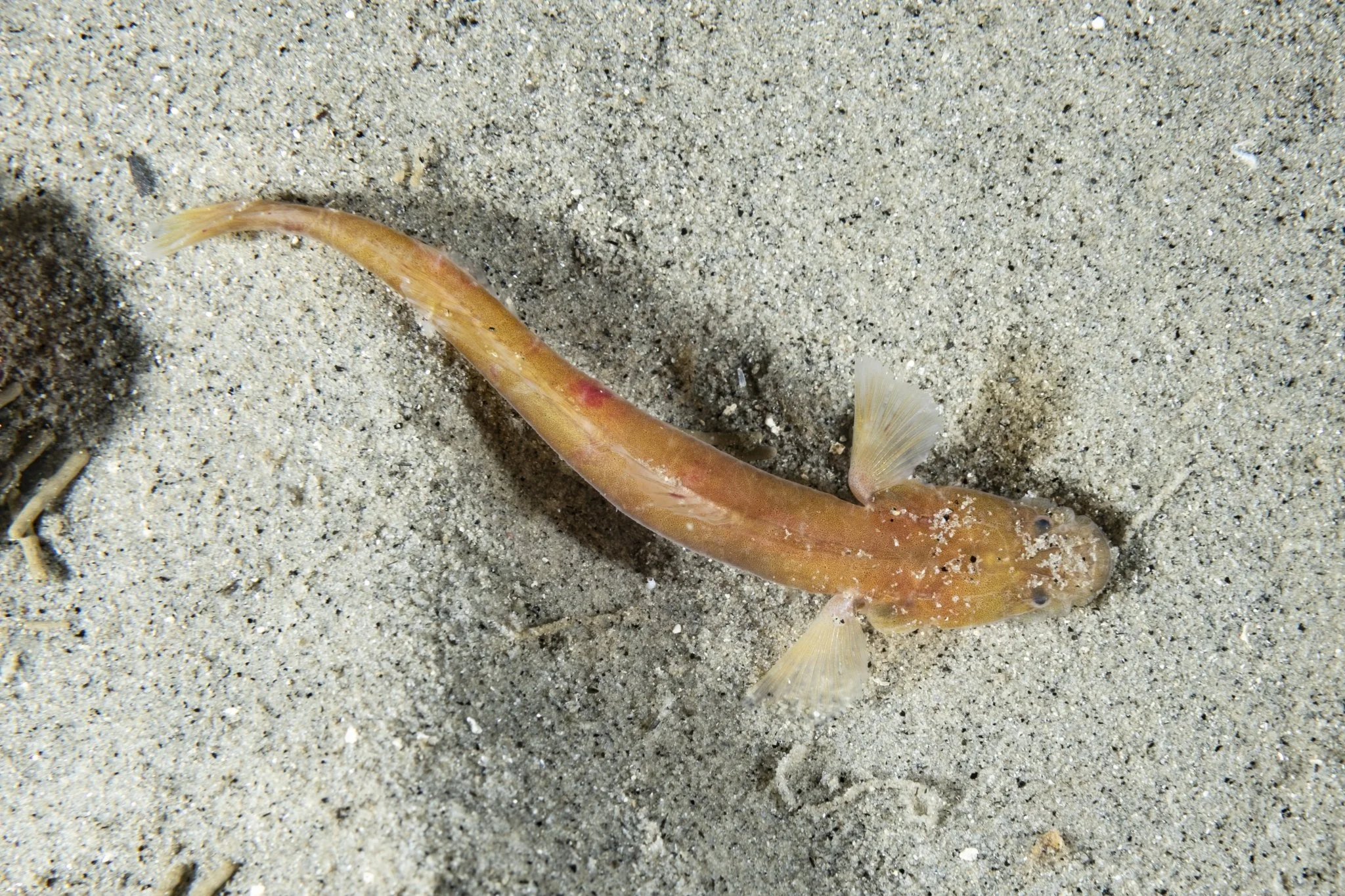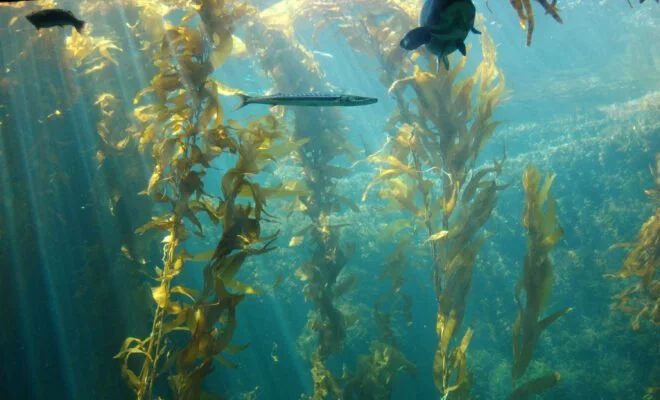Species Spotlight: Halfblind Goby
INFORMATION
The Halfblind Goby (Lethops connectens) is a rare, cryptobenthic fish endemic to the northeastern Pacific Ocean, ranging from central California (Carmel) to northern Baja California, Mexico. Biologist Carl Leavitt Hubbs first described the species in 1926 based on specimens he collected during a coastal expedition in California (Romero Jr., 2023). Hubbs named the genus “Lethops” by combining the Ancient Greek words lethe, which means “forgetfulness,” and ops, which means “eye,” in reference to their poorly developed eyes (Hubbs, 1926).
Gobies (family Gobiidae) are among the most species-rich groups of fish, comprising over 2,000 species in more than 200 genera, with the highest diversity in tropical and subtropical regions such as the Indo‑West Pacific. Most gobies are under 10 cm in length and possess fused pelvic fins forming an adhesive disc, which allows them to anchor to substrates in dynamic nearshore environments (Nelson, Grande, & Wilson, 2016).
Gobies are typically solitary or live in small groups, although some species form mutualistic relationships with alpheid (pistol) shrimp, sharing burrows that the shrimp construct and maintain. In these associations, the goby acts as a lookout for predators while the shrimp digs and cleans the burrow (Berra, 2007; Werding, Christensen, & Hiller, 2016). Gobies feed on small benthic invertebrates such as shrimp, amphipods, worms, and snails, and are important prey for seals, shorebirds, and larger fish (California Department of Fish and Game, 2001).
Reproduction in gobies involves the deposition of distinctive, club-shaped eggs that are attached to rocks or burrow ceilings with hair-like filaments. Males guard the developing clutch for five to ten days until the eggs hatch. The larvae then enter a planktonic phase before eventually settling back into benthic habitats (California Department of Fish and Game, 2001).
Adult Halfblind Gobies are typically found hiding in kelp holdfasts and rocky crevices near the seafloor, while juveniles often form small schools in the kelp canopy (Moser, 1996). The species can grow up to 8.9 cm in length and has been observed at depths ranging from the intertidal zone to about 21 meters (Love, 2021).
THREATS
The Halfblind Goby (Lethops connectens) is categorized as Vulnerable by the IUCN, primarily due to its limited area of occupancy (estimated at ~1,764 km²) and its presence at fewer than ten known locations. The species' principal threat is the widespread decline of Giant Kelp (Macrocystis pyrifera), which serves as essential habitat for both juvenile and adult gobies.
Climate Change and Ocean Warming
While natural fluctuations in kelp forests occur due to oceanographic cycles such as the North Pacific Gyre Oscillation and El Niño–Southern Oscillation (ENSO), anthropogenic climate change has intensified these disturbances by increasing sea surface temperatures and reducing nutrient upwelling. In particular, an anomalous marine heatwave known as "The Blob", combined with a strong El Niño event, led to record-breaking ocean temperatures in 2014–2015 (Bell, 2018), further exacerbating the decline of kelp and threatening kelp-dependent species like the Halfblind Goby.
Urchin Overgrazing and Trophic Imbalance
The degradation of kelp forests has been worsened by the population boom of Purple Sea Urchins (Strongylocentrotus purpuratus). This outbreak followed the mass die-off of Sunflower Sea Stars (Pycnopodia helianthoides), a key predator of sea urchins, due to the 2013 outbreak of sea star wasting disease. Without predation pressure, Purple Sea Urchins have proliferated unchecked, overgrazing vast expanses of kelp and creating barren seafloors devoid of the structure and productivity once provided by kelp (Catton, 2016).
Habitat Loss and Lack of Protection
Due to the combined effects of warming, disease, and grazing, kelp forests now persist in only 43% of their historically suitable range in the northeastern Pacific. Despite their ecological importance, these habitats remain largely unprotected. Only 7.7% of kelp habitat falls within designated protected areas, with an additional 3.9% partially protected (Arafeh-Dalmau, 2021).
Decline of Keystone Predators
The long-term absence of Sea Otters (Enhydra lutris) in southern California has contributed further to the unchecked growth of sea urchins. Once common along the entire California coast, Sea Otters were extirpated from southern California in the 19th century due to the maritime fur trade and have not naturally recolonized the area (Tinker, Staedler, & Bodkin, 2019). In contrast, in regions of central and northern California, where otter populations have persisted or recovered, sea urchin grazing pressure is more controlled, and kelp forests tend to be more resilient (Estes & Duggins, 1995; Watson et al., 2017).
Recognizing the critical ecological role Sea Otters play in coastal ecosystems, the U.S. Fish and Wildlife Service (FWS) has evaluated the potential for reintroduction of Sea Otters along the U.S. West Coast (FWS, 2022). While southern California is not a priority region in the early phases of planning, reintroduction within the northern range of the Halfblind Goby is under consideration, as parts of northern California offer suitable habitat and the potential to reconnect fragmented Sea Otter populations (FWS, 2022). However, the status of reintroduction efforts under the new Trump administration is unclear.
CONCLUSION
The Halfblind Goby remains an under-researched species, with little information available beyond the original description by Hubbs nearly 100 years ago. The species’ biology and ecology are so shrouded in mystery that no verifiable photographs exist and only scientific drawings depict its appearance. Currently, there are no species-specific conservation measures in place to protect the Halfblind Goby and its habitat. As such, further research on the species’s population status, distribution, and ecological requirements is urgently needed to ensure their conservation.
REFERENCES
Arafeh-Dalmau, N., K. C. Cavanaugh, H. P. Possingham, et al. “Southward decrease in the protection of persistent giant kelp forests in the northeast Pacific.” Communications Earth & Environment 2 (2021). https://www.nature.com/articles/s43247-021-00177-9
Bell, T. W., J. G. Allen, K. C. Cavanaugh, and D. A. Siegel. “Three decades of variability in California's giant kelp forests from the Landsat satellites.” Remote Sensing of Environment 281 (2020). https://www.researchgate.net/publication/326175540_Three_decades_of_variability_in_California's_giant_kelp_forests_from_the_Landsat_satellites
Berra, T. M. Freshwater Fish Distribution. Illinois: The University of Chicago Press, 2002.
California Department of Fish and Game. “Gobies.” California Living Marine Resources: A Status Report, 2001.
Catton, C. “‘Perfect Storm’ Decimates Northern California Kelp Forests.” Marine Management News, 2016.
https://cdfwmarine.wordpress.com/2016/03/30/perfect-storm-decimates-kelp/
Estes, J. A. and D. P. Duggins. “Sea otters and kelp forests in Alaska: Generality and variation in a community ecological paradigm.” Ecological Monographs 65(1) (1995): 75–100. https://doi.org/10.2307/2937156
Hubbs, C. L. “Notes on the Gobioid Fishes of California, With Descriptions of Two New Genera." Occasional Papers of the Museum of Zoology, University of Michigan 169 (1926): 1-7. https://deepblue.lib.umich.edu/bitstream/handle/2027.42/56608/OP169.pdf?sequence=1&isAllowed=y
Love, M. S., J. J. Bizzarro, A. M. Cornthwaite, B. W. Frable, and K. P. Maslenikov. “Checklist of marine and estuarine fishes from the Alaska–Yukon Border, Beaufort Sea, to Cabo San Lucas, Mexico.” Zootaxa 5053, no. 1 (2021): 1-285. https://www.researchgate.net/publication/355409485_Checklist_of_marine_and_estuarine_fishes_from_the_Alaska-Yukon_Border_Beaufort_Sea_to_Cabo_San_Lucas_Mexico
Moser, H. G. The Early Stages of Fishes in the California Current Region. Kansas: Allen Press, Inc., 1996.
Nelson, J. S., T. C. Grande, and M. V. H. Wilson. Fishes of the World (5th ed.). John Wiley & Sons, 2016.
Romero Jr., A. and M. Moseley. “The biospeleological work of Carl L. Hubbs (1894–1979): an appraisal.” Subterranean Biology 46, no. 4 (2023): 165-198. https://subtbiol.pensoft.net/article/114190/
Stiefel, K. M. and R. B. Reyes. “Symbiosis does not correlate with larger fish eye size” [Preprint]. bioRxiv (2018). https://doi.org/10.1101/329094
Tinker, M. T., M. Staedler, and J. Bodkin. California sea otter translocation feasibility study. U.S. Fish and Wildlife Service (2019). https://doi.org/10.13140/RG.2.2.13193.19047
Tornabene L., J. Van Tessell, R. Robertson, and O. Dominguez. “Lethops connectens.” The IUCN Red List of Threatened Species, 2025. https://dx.doi.org/10.2305/IUCN.UK.2025-1.RLTS.T241147990A241147992.en.
U.S. Fish and Wildlife Service. Feasibility Assessment for Reintroduction of Sea Otters on the U.S. West Coast: Executive Summary (2022). https://www.fws.gov/sites/default/files/documents/Executive%20Summary%20FWS%20Sea%20Otter%20Feasibility%20Study%202022.pdf
Watson, J., J. A. Estes, and M. T. Tinker. Decline in sea otter population is linked to ecosystem shifts in kelp forest communities. Ecological Applications 27(5) (2017): 1383–1395. https://doi.org/10.1002/eap.1548




